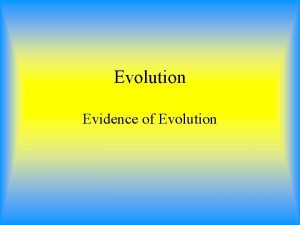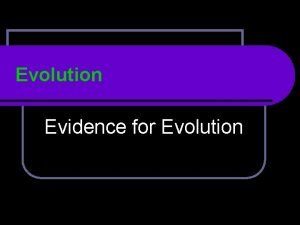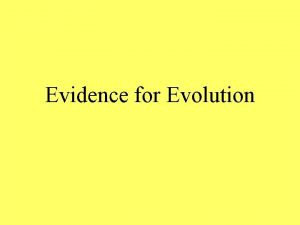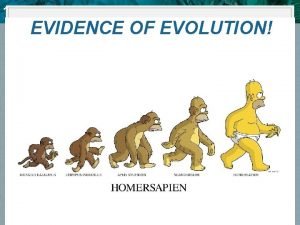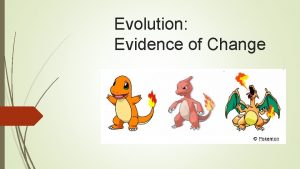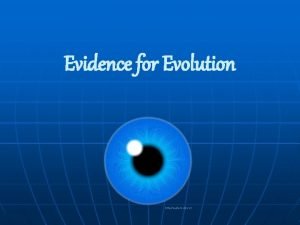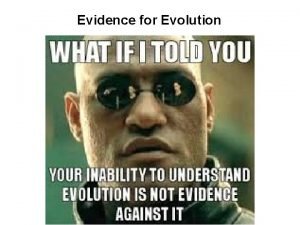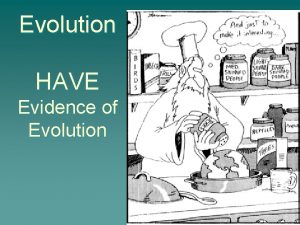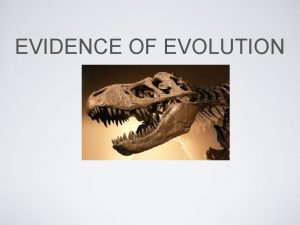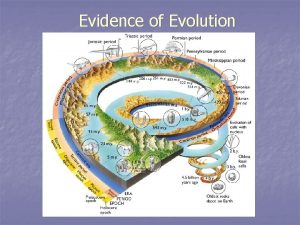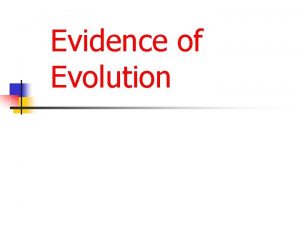Evidence for Evolution Outline Evidence of Evolution Evidence















- Slides: 15

Evidence for Evolution

Outline • Evidence of Evolution

Evidence: Fossils • What are fossils? – Preserved ancient remains of organisms • What do fossils show us? – Organisms existed in the past – Changes in organisms through time

Fossil Formation 1) Dead organism 2) Organism buried and compressed 3) High pressure of sedimentary rock mineralized the remains 4) Erosion of sedimentary rock exposes fossils

Fossil Layers • Simple organisms exist in all layers • More complex organisms found in younger rocks • Older rocks near the bottom • Rock layers seem to separate species

Living Fossils • Organisms that were thought to be extinct • Species that lived through a large portion of geological time without much changes (millions of years)


Biogeography • The study of the geographic distribution of organisms based on living species and fossils • Darwin laid the foundation • Hypothesized that species arrived by water or air and populated remote islands • Species established then evolved into new species over time

• Evolution offers the best explanation for why many species on remote islands are found nowhere else • See Table 1 on pg. 297 Observations from the Galapagos Islands Darwin’s hypotheses regarding remote islands Many species of plants, birds, insects, and, in some cases, reptiles Only these kinds of organisms are able to reach remote islands by crossing large expanses of open ocean No native amphibians and very few land mammals Amphibians and most mammals are unable to cross open ocean and will not be found on remote islands Many unique species found nowhere else on Earth Over time, ancestral species have evolved into new geographically isolated species Unique species most closely resemble species on the nearest continental land mass Unique species are descendents of ancestral species from the nearest continental land masses and will exhibit some similarities

Homologous and Analogous • Homologous: a structure with a common evolutionary origin but serve different functions Examples: human arm and horse leg

Figure 7 on pg. 299 • shared features: tails and gill slits

• Analogous: a structure with same function but not similar in origin Examples: bird wings and insect wings

Vestigial Features • A rudimentary and non-functioning structure • Examples: – Many mammals possess vestigial toes

• Other examples: – Hip bones in whale and snakes – Human goosebumps – Is human hair a vestigial feature? Why or why not?

Exit Card 1) Name at least one more vestigial feature in humans 2) Compare a lobster claw to an ape hand. Would you say the features are homologous or analogous? 3) Thinking back to all we have learned so far, what other questions do you have?
 Sentence outline examples
Sentence outline examples Tobinskatten för och nackdelar
Tobinskatten för och nackdelar Egg för emanuel
Egg för emanuel Tack för att ni har lyssnat
Tack för att ni har lyssnat Byggprocessen steg för steg
Byggprocessen steg för steg Personlig tidbok
Personlig tidbok Rutin för avvikelsehantering
Rutin för avvikelsehantering Var finns arvsanlagen
Var finns arvsanlagen Presentera för publik crossboss
Presentera för publik crossboss Rådet för byggkompetens
Rådet för byggkompetens Iso 22301 utbildning
Iso 22301 utbildning Myndigheten för delaktighet
Myndigheten för delaktighet Kung som dog 1611
Kung som dog 1611 Tack för att ni har lyssnat
Tack för att ni har lyssnat Stig kerman
Stig kerman Referat mall
Referat mall
















